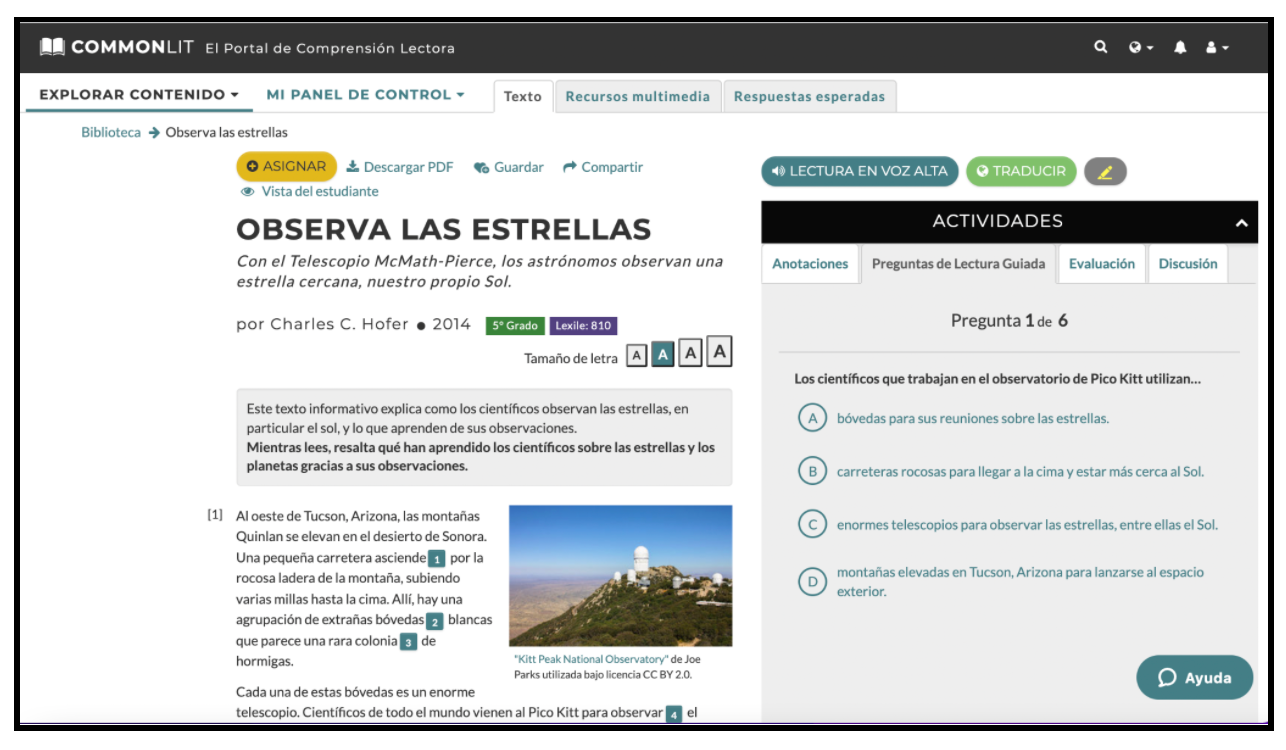These informational texts from CommonLit Español will get students excited to learn about the world around them!
Students are full of questions about the world around them. Why does the weather change each day? How do computers work? Why do we only see stars at night? Reading scientific articles is a great way for students to learn new facts, broaden their background knowledge, and make connections.
Here is a great set of Spanish informational texts about science and technology for grades 3–9. These articles teach students about a variety of topics and processes.
“El ciclo del agua” by Nathan Asher Katzin (3rd Grade)
In this informational text, the author describes the water cycle, one of the earth’s natural recycling processes. Developing an understanding of how water exists in different forms at different temperatures is crucial for budding scientists.
As students read, have them follow the annotation task, which asks them to underline the different forms of water. To help students synthesize their learning after reading, have them refer to their notes to create an illustrated model of the water cycle. Students’ visuals should include each form of water and show how it moves through the earth and the oceans.
“La selva tropical de Sudamérica: Húmeda y caliente” by Nancy White (4th Grade)
In this article, the author describes the attributes of rainforests and the animals that live in them. Rainforests are composed of several levels, and different animals like monkeys, frogs and big cats live in different sections.
Before reading, help students build background knowledge about ecosystems by watching the video “What is an ecosystem?” under the “Related Media” tab. After watching, have students discuss what makes an ecosystem to prepare them to understand the characteristics of rainforests in the text.
“Observa las estrellas” by Charles C. Hofer (5th Grade)
In this informational text, students will learn how astronomers use the McMath-Pierce Telescope located in Tucson, Arizona. Scientists from all over the world use the telescope to learn more about the sun, stars and planets. Studying the sun in particular is critical for these scientists, as the sun sustains life on Earth.
This text is full of complex scientific ideas and vocabulary, so to support students, consider turning on Guided Reading Mode. This tool chunks the text into smaller pieces and has students answer basic comprehension questions as they read. Guided Reading Mode is a great way to help students monitor their own understanding of the text!

“El método científico” by Barrett Smith (6th Grade)
In this article, the author describes the steps of the scientific method, which was originally developed by the ancient Greeks and refined over centuries. When designing and executing an experiment, it is important for scientists to follow these steps to ensure the validity of their results. The scientific method helps people better understand the world around them.
As an extension after reading, have students design their own science experiment. They can ask a question about a topic that interests them, design a hypothesis, then write a plan for how they would test and analyze their hypothesis.
“El sol como batería” by Wanda Mártir (7th Grade)
In this article, the author tracks the development of solar energy as a power source and discusses its environmental benefits. Thanks to scientific and technological advances, it is possible to transform energy from the sun into energy for various purposes at a lower cost than in the past.
Spark a debate about the use of solar energy by watching the video “Energía solar: Ventajas y desventajas” under the “Related Media” tab. Have students consider the pros and cons of installing solar panels to power their own communities. Students can also make connections to what they know about other forms of renewable energy, such as wind or hydroelectric power.

“La computadora” by Ingrid Sanhueza (7th Grade)
In this informational text, the author describes the first computers and how they evolved into the technology we use today. People have used tools for calculations for thousands of years and, over time, these tools became more and more sophisticated. Students will be surprised to learn how old “computers” really are.
As students read, have them follow the annotation task, which asks them to take notes on the characteristics of the first computers. Then, have students make text-to-world connections by comparing each version of the “computer” to the devices they use today. As an extension activity, students could also make a timeline that tracks the changes in technology over the years.
“El caso del celular fantasma” by Martín Bonfil Olivera (8th Grade)
In this article, students are asked if they have ever felt their cell phone vibrate when it actually did not. This common occurrence is an example of how our senses can deceive us. Our perception of what we hear, see, and feel can sometimes be misleading.
Extend students’ learning after reading by watching the video “Efectos ópticos” under the “Related Media” tab. As students experience the optical illusions in the video, ask them to reflect on what they notice and feel. Have them make connections back to the explanation in the article for how people’s eyes and brains can perceive what they “see” incorrectly.
“El cambio climático agrava tus alergias” by National Geographic (9th Grade)
In this informational text, students will learn why some people experience allergies in the spring. When people are allergic to pollen, their bodies treat it like a parasite and try to remove it. Unfortunately, climate change is making allergies worse, but the article offers several solutions for allergy sufferers.
After reading, encourage students to make text-to-world connections using their knowledge from science class. Use Discussion Question 2, “El texto revela que el calentamiento del planeta está agravando las alergias. ¿Cuáles son las causas? ¿Qué otro daño a la salud puede provocar este cambio en el clima? ¿Qué podemos hacer para evitar estos daños?” In English, the question is, “The text reveals that climate change is exacerbating allergies. What are the causes? What other damages to health can climate change cause? What can we do to avoid these damages?”
Next Steps
Looking for more Spanish texts on CommonLit? Browse the CommonLit Español library!
If you’re interested in learning all about CommonLit’s free Spanish digital literacy program, join one of our upcoming webinars!


